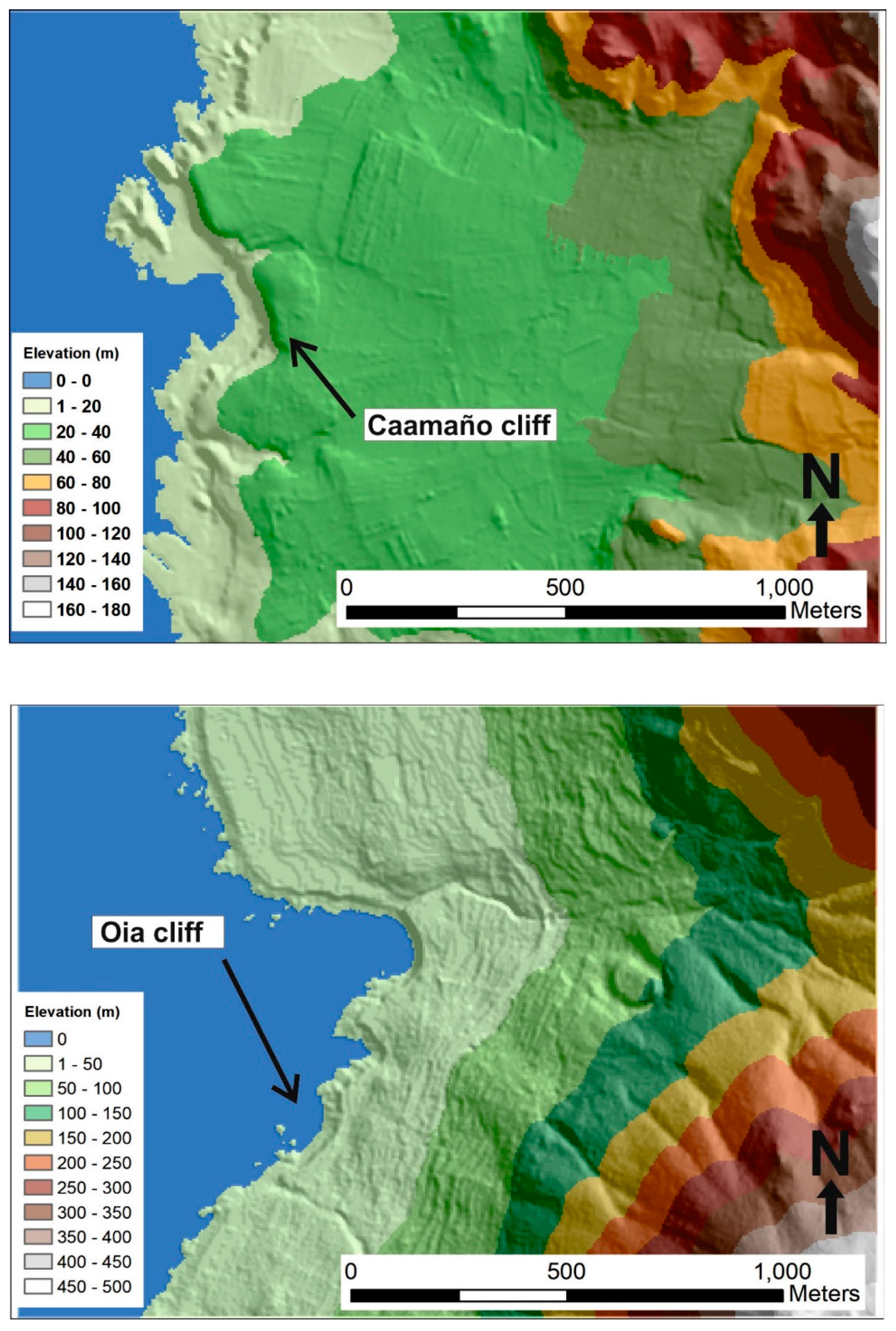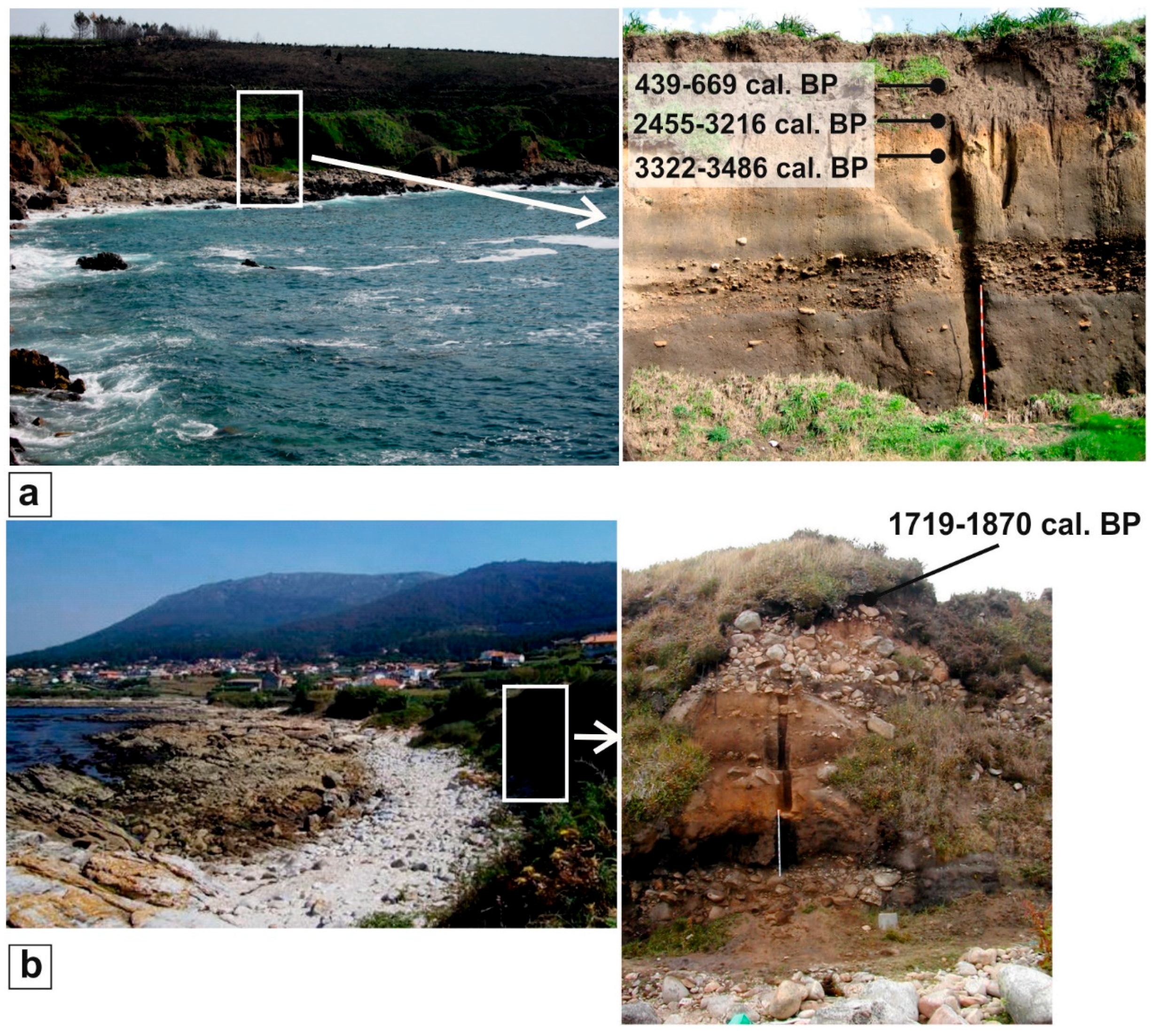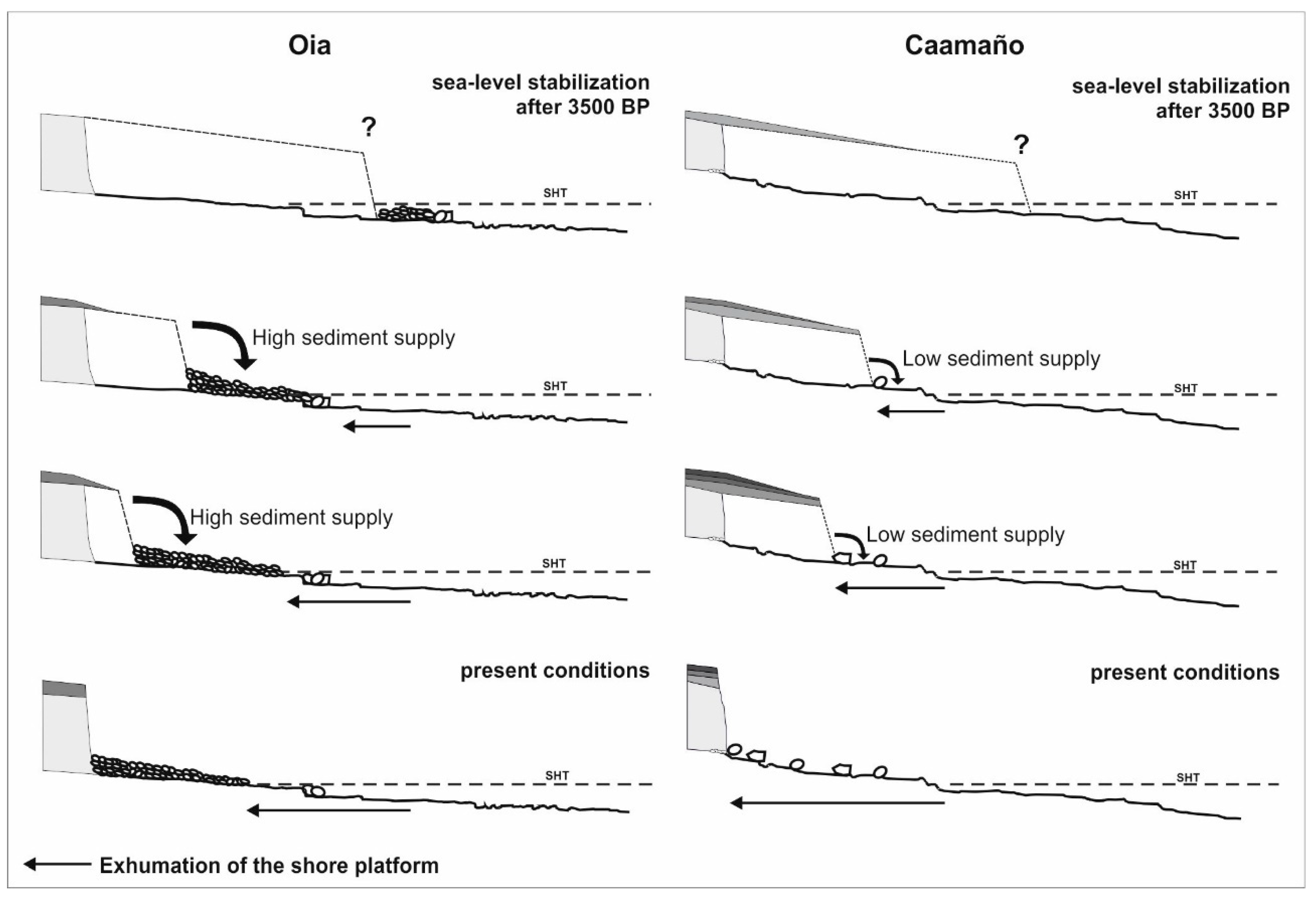Coastal Retreat and Sedimentation during the Last 3000 Years. Atlantic Coast of NW Spain
Abstract
1. Introduction
2. Regional Setting
3. Materials and Methods
4. Results
5. Discussion
6. Conclusions
Author Contributions
Funding
Conflicts of Interest
References
- Forbes, D.L.; Syvitski, J.P.M. Paraglacial coasts. In Coastal Evolution. Late Quaternary Shoreline Morphodynamics, 1st ed.; Carter, R.W.G., Woodroffe, C.D., Eds.; Cambridge University Press: Cambridge, UK, 1994; pp. 373–424. [Google Scholar]
- Haslett, S.K.; Curr, R.H.F. Stratigraphy and palaeoenvironmental development of Quaternary coarse clastic beach deposits at Plage de Mezpeurleuch, Brittany (France). Geol. J. 2001, 36, 171–182. [Google Scholar] [CrossRef]
- Blanco-Chao, R.; Pérez Alberti, A.; Trenhaile, A.S.; Costa-Casais, M.; Valcárcel Díaz, M. Shore platform abrasion in a para-periglacial environment, Galicia, northwestern Spain. Geomorphology 2007, 83, 136–151. [Google Scholar] [CrossRef]
- Costa-Casais, M. Análise Sedimentaria e Reconstrucción Paleoambiental da Costa Atlántica de Galicia. Ph.D. Thesis, Servicio de Publicacións e Intercambio Científico da U.S.C, Santiago de Compostela, Spain, 2001; 236p. [Google Scholar]
- Costa-Casais, M.; Moares Domínguez, C.; Martínez-Cortizas, A. Caracterización físico-química do depósito litoral de Mougás (Pontevedra): Implicacións morfoxenéticas. In Dinámica y Evolución de Medios Cuaternarios, 1nd ed.; Pérez Alberti, A., Martini, P., Chesworth, W., Martínez Cortizas, A., Eds.; Xunta de Galicia: Santiago de Compostela, Spain, 1996; pp. 431–440. [Google Scholar]
- Costa-Casais, M.; Pérez-Alberti, A.; Blanco-Chao, R. Depósitos coluviales de origen nival en la costa sur de Pontevedra (Galicia): Facies y procesos deposicionales. In Estudios Recientes (2000–2002) en Geomorfología. Patrimonio, Montaña y Dinámica Territorial, 1st ed.; Serrano, E., García de Celis, A., Guerra, J.C., Morales, C.G., Ortega, M.T., Eds.; Dpto. de Geografía-Universidad de Valladolid. SEG: Valladolid, Spain, 2002; pp. 539–546. [Google Scholar]
- Pérez Alberti, A.; Costa Casais, M.; Blanco Chao, R. L’importance des processes d’origine froide sur la cote Atlantique de la Galice (nord-ouest de la peninsule Iberique). Environ. Périglac. Bull. L’Assoc. Fr. Périglac. 1998, 5, 21–32. [Google Scholar]
- Blanco-Chao, R.; Costa-Casais, M.; Martínez-Cortizas, A.; Pérez Alberti, A.; Trenhaile, A.S. Evolution and inheritance of a rock coast: Western Galicia, northwestern Spain. Earth Surf. Process. Landf. 2003, 28, 757–775. [Google Scholar] [CrossRef]
- Trenhaile, A.S.; Pérez Alberti, A.; Martínez Cortizas, A.; Costa Casais, M.; Blanco Chao, R. Rock coast inheritance: An example from Galicia, Northwestern Spain. Earth Surf. Process. Landf. 1994, 24, 605–621. [Google Scholar] [CrossRef]
- Santos-Fidalgo, M.L.; Vidal-Romaní, J.R. El lagoon de Seselle: Un episodio de la transgresión Holocena en la Ria de Ares (A Coruña, Galicia, España). Datos geomorfológicos, sedimentarios y paleoecológicos. Cuad. Lab. Geol. Laxe 1995, 18, 163–174. [Google Scholar]
- Dias, J.M.A.; Boski, T.; Rodrigues, A.; Magalhaes, F. Coast line evolution in Portugal since the last glacial maximum until present-a synthesis. Mar. Geol. 2000, 170, 177–186. [Google Scholar] [CrossRef]
- Freitas, M.C.; Andrade, C.; Cruces, A. The geological record of environmental changes in southwestern Portuguese coastal lagoons since the Lateglacial. Quat. Int. 2002, 93–94, 161–170. [Google Scholar] [CrossRef]
- Freitas, M.C.; Andrade, C.; Rocha, F.; Tassinari, C.; Munhá, J.M.; Cruces, A.; Vidinha, J.; da Silva, C.M. Lateglacial and Holocene environmental changes in Portuguese coastal lagoons1: The sedimentological and geochemical records of the Santo André coastal area. Holocene 2003, 13, 433–446. [Google Scholar] [CrossRef]
- Bao, R.; Alonso, A.; Delgado, C.; Pagés, J.L. Identification of the main driving mechanisms in the evolution of a small coastal wetland (Traba, Galicia, NW Spain) since its origin 5700 cal yr BP. Palaeogeogr. Palaeoclimatol. Palaeoecol. 2007, 247, 296–312. [Google Scholar] [CrossRef]
- Costas-Otero, S. Origen y Evolución del Conjunto Playa-Duna-Lagoon de Cíes (Parque Nacional Marítimo-Terrestre de Las Islas Atlánticas de Galicia), 1st ed.; Organismo Autónomo Parques Nacionales. Ministerio de Medio Ambiente: Madrid, Spain, 2008; 191p. [Google Scholar]
- Costas-Otero, S.; Muñoz Sobrino, C.; Alejo, I.; Pérez-Arlucea, M. Holocene evolution of a rock-bounded barrier lagoon system, Cíes Islands, northwest Iberia. Earth Surf. Process. Landf. 2009, 34, 1575–1586. [Google Scholar] [CrossRef]
- Martins, V.; Jouanneau, J.M.; Weber, O.; Rocha, F. Tracing the late Holocene evolution of the NW Iberian upwelling system. Mar. Micropaleontol. 2006, 59, 35–55. [Google Scholar] [CrossRef]
- Alvarez, M.C.; Flores, J.A.; Sierro, F.J.; Diz, P.; Francés, G.; Pelejero, C.; Grimalt, J. Millennial surface water dynamics in the Ria de Vigo during the last 5000 years as revealed by coccoliths and molecular biomarkers. Palaeogeogr. Palaeoclimatol. Palaeoecol. 2005, 218, 1–13. [Google Scholar] [CrossRef]
- González-Álvarez, R.; Bernárdez, P.; Pena, L.D.; Francés, G.; Prego, R.; Diz, P.; Vilas, F. Paleoclimatic evolution of the Galician continental shelf (NW of Spain) during the last 3000 years: From a storm regime to present conditions. J. Mar. Syst. 2004, 54, 245–260. [Google Scholar] [CrossRef]
- Dawson, A.; Elliott, A.; Noone, S.; Hickey, K.; Holt, T.; Wadhams, P.; Foster, I. Historical storminess and climate ‘see-saws’ in the North Atlantic region. Mar. Geol. 2004, 210, 247–259. [Google Scholar] [CrossRef]
- Meeker, L.D.; Mayewski, P.A. A 1400 year high-resolution record of atmospheric circulation over the North Atlantic and Asia. Holocene 2002, 12, 257–266. [Google Scholar] [CrossRef]
- Food and Agriculture Organization of the United Nations. A Framework for International Classification, Correlation and Communication; Food and Agriculture Organization of the United Nations: Rome, Italy, 2006. [Google Scholar]
- Munsell Color Co. Inc. Munsell Soil Color Charts; Munsell Color Co. Inc.: Baltimore, MD, USA, 1975. [Google Scholar]
- Trenhaile, A.S. Modeling the development of wave-cut shore platforms. Mar. Geol. 2000, 166, 163–178. [Google Scholar] [CrossRef]
- Trenhaile, A.S. Modeling the development of marine terraces on tectonically mobile rock coasts. Mar. Geol. 2002, 185, 341–361. [Google Scholar] [CrossRef]
- Komar, P.D.; Gaughan, M.K. Airy wave theory and breaker height prediction. In Proceedings of the 13th Coastal Engineering Conference, American Society of Civil Engineers, Vancouver, BC, Canada, 10–14 July 1972; pp. 405–418. [Google Scholar]
- Costa-Casais, M.; Caetano Alves, M.I. Geological heritage at risk in NW Spain. Quaternary deposists and landforms of “Southern Coast” (Baiona-A Garda). Geoheritage 2013, 5, 227–248. [Google Scholar] [CrossRef]
- Martínez-Cortizas, A.; Moares Domínguez, C. Edafología y Arqueología: Estudio de Yacimientos Arqueológicos al Aire Libre en Galicia; Consellería de Cultura. Xunta de Galicia: Santiago de Compostela, Spain, 1995; 199p. [Google Scholar]
- Martínez-Cortizas, A.; Fábregas Válcarce, R.; Franco Maside, S. Evolución del paisaje y actividad humana en el área de Monte Penide (Redondela, Pontevedra): Una aproximación metodológica. Trab. Prehist. 2000, 57, 173–184. [Google Scholar] [CrossRef]
- Van Geel, B.; Buurman, J.; Waaterbolk, H.T. Archaeological and palaeoecological indications of an abrupt climate change in The Netherlands an evidence for climatological teleconnections around 2650 BP. J. Quat. Sci. 1996, 11, 451–460. [Google Scholar] [CrossRef]
- Van Geel, B.; Heusser, C.J.; Rensen, H.; Schumans, C.J.E. Climatic change in Chile at around 2700 BP and global evidence for solar forcing: A hypothesis. Holocene 2000, 10, 659–664. [Google Scholar] [CrossRef]
- Van Mourik, J.M. Pollen Profiles of Slope Deposits in the Galician Area (NW Spain). Ph.D. Thesis, Universiteit van Amsterdam, Amsterdam, The Netherlands, 1985; 171p. [Google Scholar]
- Van Mourik, J.M. The use of micromorphology in soil pollen analysis. The interpretation of the pollen content of slope deposits in Galicia, Spain. Catena 1999, 35, 239–257. [Google Scholar] [CrossRef]
- Fábregas-Valcarce, R.; Martínez-Cortizas, A.; Blanco-Chao, R.; Chesworth, W. Environmental change and social dynamics in the second-third millenium BC in NW Iberia. J. Archaeol. Sci. 2003, 30, 859–871. [Google Scholar] [CrossRef]
- Martínez Cortizas, A.; Mighall, T.; Pombal, X.; Novoa-Muñoz, J.C.; Peiteado-Varela, E.; Piñeiro-Rebolo, R. Linking changes in atmospheric dust deposition, vegetation change and human activities in northwestern Spain during the last 5300 years. Holocene 2005, 15, 698–706. [Google Scholar] [CrossRef]
- Martínez-Cortizas, A.; Costa-Casais, M.; López-Sáez, J.A. Environmental change in NW Iberia between 7000 and 500 cal BC. Quat. Int. 2009, 200, 77–89. [Google Scholar] [CrossRef]
- Martínez-Cortizas, A.; Kaal, J.; Costa-Casais, M.; Chesworth, W. Human activities and Holocene environmental change in NW Spain. In Control de la Degradación de Los Suelos y Cambio Globa, 2nd ed.; Sánchez Díaz, J., Asins Velis, S., Eds.; IV Simposio Nacional. CDSCG: Valencia, Spain, 2009; pp. 193–208. [Google Scholar]
- Mighall, T.M.; Martínez-Cortizas, A.; Biester, H.; Turner, S.E. Proxy climate and vegetation changes during the last five millennia in NW Iberia: Pollen and non-pollen palynomorph data from two ombrotrophic peat bogs in the North Estern Iberian Peninsula. Rev. Palaeobot. Palynol. 2006, 141, 203–223. [Google Scholar] [CrossRef]
- Kaal, J.; Costa Casais, M.; Ferro Vázquez, C.; Pontevedra Pombal, X.; Martínez Cortizas, A. Soil formation of “Atlantic Rankers” from NW Spain. A high resolution aluminium and iron fractionation study. Pedosphere 2008, 18, 441–453. [Google Scholar] [CrossRef]
- Kaal, J.; Martínez-Cortizas, A.; Eckmeier, E.; Costa-Casais, M.; Santos-Estévez, M.; Criado-Boadio, F. Holocene fire history of black colluvial soils revealed by pyrolysis-CG/MS: A case study from Campo Lameiro (NW Spain). J. Archaeol. Sci. 2008, 35, 2133–2143. [Google Scholar] [CrossRef]
- Mücher, H.J.; Carballas, T.; Guitián Ojea, F.; Jungerius, P.D.; Kroonenberg, S.B.; Villar, M.C. Micromorphological analysis of effects of alternating phases of landscape stability and instability on two soil profiles in Galicia, N.W. Spain. Geoderma 1972, 8, 241–266. [Google Scholar] [CrossRef]
- Gómez-Orellana, L.; Ramil-Rego, P.; Muñoz-Sobrino, C. Una nueva secuencia polínica y cronológica para el depósito pleistoceno de Mougás (NW de la Península Ibérica). Rev. Paléobiol. 1998, 17, 35–47. [Google Scholar]
- Carrión Marco, Y. La Vegetación Mediterránea y Atlántica de la Península Ibérica: Nuevas Secuencias Antracológicas; Servicio de Investigación Prehistórica. Serie de Trabajos Varios, núm. 104; Diputación Provincial de Valencia: València, Spain, 2005; 314p. [Google Scholar]
- Martínez-Cortizas, A.; Pontevedra-Pombal, X.; Nóvoa Muñoz, J.C.; García-Rodeja, E. Four thousand years of atmospheric Pb, Cd and Zn deposition recorded by the ombrotrophic peatbog of Penido Vello (Nortwestern Spain). Water Air Soil Pollut. 1997, 100, 387–403. [Google Scholar] [CrossRef]
- Martínez-Cortizas, A.; Pontevedra-Pombal, X.; Nóvoa Muñoz, J.C.; García-Rodeja, E.; Shotyk, W. Mercury in a Spanish peat bg: Archive of climate change and atmospheric metal deposition. Science 1999, 284, 939–942. [Google Scholar] [CrossRef] [PubMed]
- Martínez-Cortizas, A.; García-Rodeja, E.; Pontevedra-Pombal, X.; Nóvoa Muñoz, J.C.; Weis, D.; Cheburkin, A. Atmospheric Pb deposition in Spain during the last 4.600 years record by two ombrotrophic peat bogs and implications for the use of peat as a geochemical archive. Sci. Total Environ. 2002, 292, 33–44. [Google Scholar] [CrossRef]
- Costa-Casais, M.; Martínez-Cortizas, A.; Pontevedra-Pombal, X.; Criado-Boado, F. Analysis of landforms in geoarchaeology: Campo Lameiro, NW Iberian Peninsula. Memorie descrittive della Carta Geologica d’Italia 2009, 86, 39–50. [Google Scholar]





| Sample | Site | 14C yr. BP | 2σ cal yr. BP | Source |
|---|---|---|---|---|
| GrN22279 | Caamaño | 530 ± 80 | 440–670 | Trenhaile et al. (1999) |
| GrN22280 | Caamaño | 2720 ± 140 | 2455–3215 | Trenhaile et al. (1999) |
| Ua-33774 | Caamaño | 3180 ± 50 | 3320–3485 | This study |
| GrN20506 | Caamaño | 36,050 ± 1430 | - | Trenhaile et al. (1999) |
| Ua33776 | Oia | 1860 ± 30 | 1720–1870 | Costa-Casais and Caetano Alves (2013) |
| Ua33777 | Oia | 25,440 ± 415 | - | Costa-Casais and Caetano Alves (2013) |
| Ua33780 | Oia | 35,650 ± 1475 | - | Costa-Casais and Caetano Alves (2013) |
© 2019 by the authors. Licensee MDPI, Basel, Switzerland. This article is an open access article distributed under the terms and conditions of the Creative Commons Attribution (CC BY) license (http://creativecommons.org/licenses/by/4.0/).
Share and Cite
Blanco-Chao, R.; Costa-Casais, M.; Cajade-Pascual, D.; Gómez-Rey, G. Coastal Retreat and Sedimentation during the Last 3000 Years. Atlantic Coast of NW Spain. J. Mar. Sci. Eng. 2019, 7, 331. https://doi.org/10.3390/jmse7100331
Blanco-Chao R, Costa-Casais M, Cajade-Pascual D, Gómez-Rey G. Coastal Retreat and Sedimentation during the Last 3000 Years. Atlantic Coast of NW Spain. Journal of Marine Science and Engineering. 2019; 7(10):331. https://doi.org/10.3390/jmse7100331
Chicago/Turabian StyleBlanco-Chao, Ramón, Manuela Costa-Casais, Daniel Cajade-Pascual, and Gonzalo Gómez-Rey. 2019. "Coastal Retreat and Sedimentation during the Last 3000 Years. Atlantic Coast of NW Spain" Journal of Marine Science and Engineering 7, no. 10: 331. https://doi.org/10.3390/jmse7100331
APA StyleBlanco-Chao, R., Costa-Casais, M., Cajade-Pascual, D., & Gómez-Rey, G. (2019). Coastal Retreat and Sedimentation during the Last 3000 Years. Atlantic Coast of NW Spain. Journal of Marine Science and Engineering, 7(10), 331. https://doi.org/10.3390/jmse7100331






